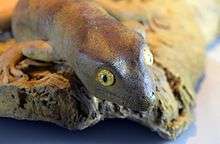Kawekaweau
| Hoplodactylus delcourti | |
|---|---|
 | |
| Scientific classification | |
| Kingdom: | Animalia |
| Phylum: | Chordata |
| Subphylum: | Vertebrata |
| Class: | Reptilia |
| Order: | Squamata |
| Suborder: | Lacertilia |
| Infraorder: | Gekkota |
| Family: | Diplodactylidae |
| Genus: | Hoplodactylus |
| Species: | H. delcourti |
| Binomial name | |
| Hoplodactylus delcourti Bauer & Russell, 1986 [2] | |
The kawekaweau (Hoplodactylus delcourti), also commonly known as Delcourt's sticky-toed gecko[3] or Delcourt's giant gecko, is an extinct species of lizard which is one of the largest known of all geckos with a snout-to-vent length of 370 mm (14.6 in) and an overall length of at least 600 mm (23.6 in),[4] surpassed only in size by the 40 centimetres (16 in) Rodriguez Island night gecko, Phelsuma gigas.[5] The Kawekaweau was endemic to New Zealand, and is now believed to be extinct.[1][lower-alpha 1]
History
According to his own report, in 1870, a Māori chief killed a kawekaweau he found under the bark of a dead rata tree in the forests of the Waimana Valley[8] (now protected as part of the northern section of Te Urewera National Park[9]). This is the only documented report of anyone ever seeing one of these animals alive.[8] He described it as being "brownish with reddish stripes and as thick as a man's wrist." Whether his story was true or not is unknown. A single stuffed museum specimen was "discovered" in the basement of the Natural History Museum of Marseille in 1986;[7] however, the origins and date of collection of the specimen remain a mystery, as when it was found, it was not labelled.[8] Scientists examining it eventually concluded it was from New Zealand and was in fact the lost "kawekaweau", a giant and mysterious forest lizard of Maori oral tradition.
Etymology
This animal's specific epithet is taken from the surname of French museum worker Alain Delcourt, who discovered the forgotten specimen in the basement of the Natural History Museum of Marseille.[3][7]
Notes
- ↑ The largest extant species of gecko is Leach's giant gecko of New Caledonia, at 360 mm (14.2 in) long;[6] the Duvaucel's gecko is the largest surviving species of gecko in New Zealand, also one of the largest in the world.[7]
References
- 1 2 World Conservation Monitoring Centre (1996). "Hoplodactylus delcourti ". IUCN Red List of Threatened Species. Version 2013.1. International Union for Conservation of Nature. Retrieved 2013-10-04.
- ↑ The Reptile Database. www.reptile-database.org.
- 1 2 Beolens B, Watkins M, Grayson M. 2011. The Eponym Dictionary of Reptiles. Baltimore: Johns Hopkins University Press. xiii + 296 pp. ISBN 978-1-4214-0135-5. (Hoplodactylus delcourti, p. 69).
- ↑ Kerry-Jayne Wilson (2004). Flight of the Huia: Ecology and Conservation of New Zealand's Frogs, Reptiles, Birds and Mammals. Christchurch, N.Z: Canterbury University Press. ISBN 0-908812-52-3.
- ↑ Gunther, A. (1879). "The Extinct Reptiles of Rodriguez". Philosophical Transactions of the Royal Society of London. 168: 452. doi:10.1098/rstl.1879.0045.
- ↑ Allison Ballance and Rod Morris, Island Magic; Wildlife of the South Seas, David Bateman publishing, 2003.
- 1 2 3 Brian Gill and Tony Whitaker, New Zealand Frogs and Reptiles, David Bateman Publishing, 1996. ISBN 978-1869532642.
- 1 2 3 Bauer AM, Russell AP. "Hoplodactylus delcourti n. sp. (Reptilia: Gekkonidae), the largest known gecko", New Zealand Journal of Zoology (1986), Vol. 13: 141–148. doi:10.1080/03014223.1986.10422655
- ↑ "Waimana Valley tracks". New Zealand Department of Conservation. Retrieved 2013-10-04.
Further reading
- New Zealand frogs and reptiles, Brian Gill and Tony Whitaker, David Bateman publishing, 1996
External links
| Wikispecies has information related to: Hoplodactylus delcourti |
